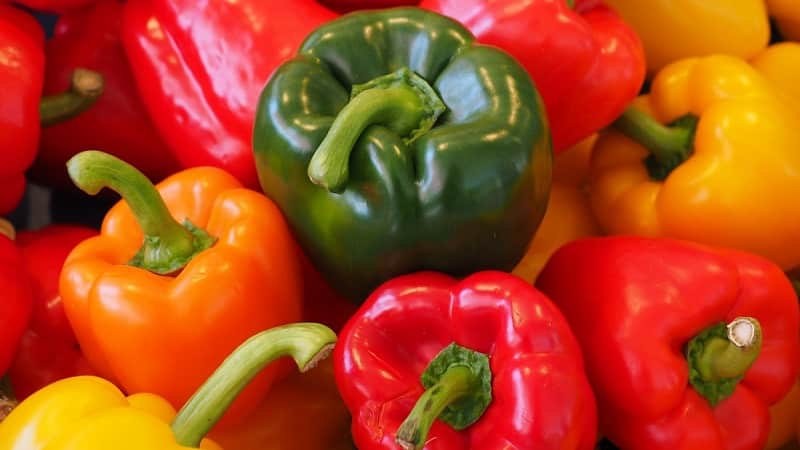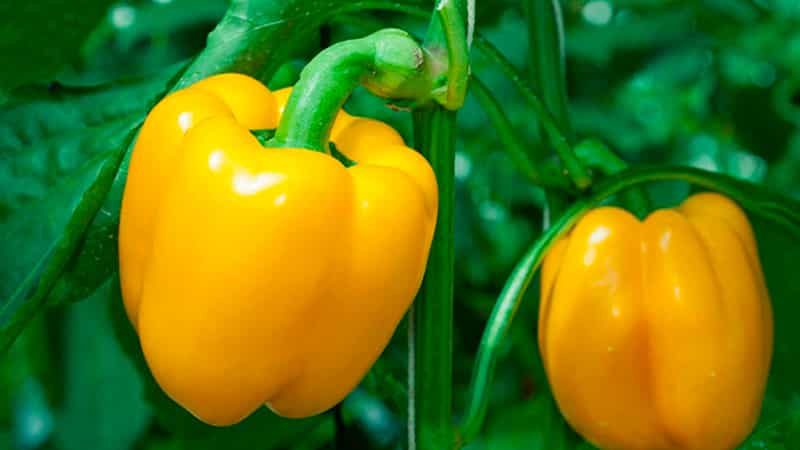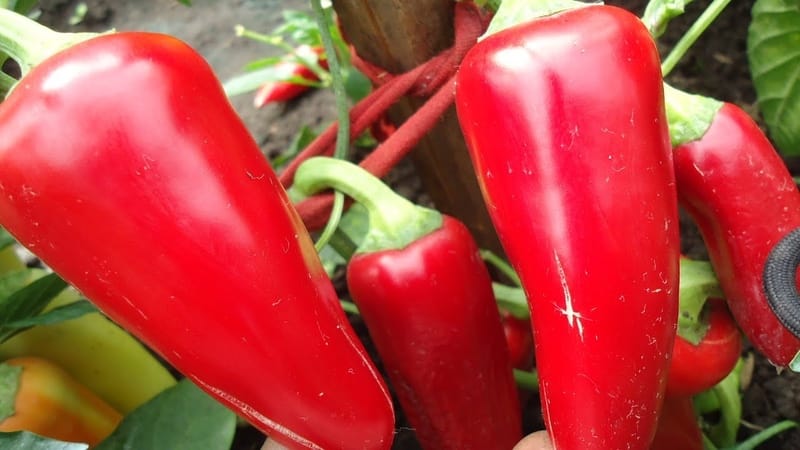Top best early varieties of sweet peppers for open ground and greenhouses
Sweet peppers are frozen for the winter, stuffed, and used for making salads and side dishes. Juicy and sweet pulp goes harmoniously with vegetables and herbs, meat and fish.
To grow a rich harvest of bell pepper on their plot, gardeners choose a variety based on the climatic conditions of the region, plant immunity, and productivity indicators. In the article we will look at how to choose varieties and which early ripening sweet peppers are most popular.
The best varieties and hybrids of early sweet peppers for open ground
Peppers are grown in open ground by summer residents of the southern regions. Such areas are characterized by a temperate climate, windlessness, nutritious and loose soil. We will study further which hybrids and early varieties of sweet peppers for open ground are preferred by gardeners.

Early miracle
The hybrid Early Miracle F1 ripens 90 days after the appearance of the first shoots. The plant is bushy, low growing. The foliage is dense and dark green in color. Planted by seedlings - seedlings are prepared in mid-March. They are transferred to the ground in May, after the last spring frosts. The hybrid loves fertile and loose soils, saturated with phosphorus and calcium.
The fruits are cone-shaped, oblong. The color is rich red, the peel is smooth and glossy. The weight of the pepper varies from 100 to 130 g. The wall thickness is 8 mm, the crop is stored for up to two months and can be transported over long distances.The yield is stable; summer residents collect 13-16 red fruits from one plant.
Ivanhoe
Yield variety Ivanhoe gives the first harvest in 100-110 days. The fruits are cone-shaped, slightly flattened. Wall thickness 7 mm, few seeds. The peel is glossy, red.
The variety is valued for its attractive commercial qualities, tasty and juicy pulp, and sweet aroma. Ivanhoe is immune to diseases and pests and is unpretentious in care. To get the best harvest, it is recommended to plant peppers after cabbage, potatoes or legumes.
Interesting! Sweet peppers contain vitamins A, B, C, E, calcium, magnesium, phosphorus and other trace elements. Regular consumption of the vegetable normalizes the functioning of the gastrointestinal tract, improves the condition of the skin and hair.
Sweet chocolate
Original fruits ripen in 110-120 days. The bushes are low, about 70 cm. The fruits are oblong, the color is burgundy-brown, weight is about 80 g. The wall thickness is from 5 to 7 mm. The pulp is sweet and juicy and is universal in use.
The Sweet Chocolate variety is planted both as seedlings and seeds in open ground. Care consists of timely fertilizing, watering and loosening the beds.
Chord
It belongs to hybrids and has strong immunity to bad weather and diseases. Accord is a mid-early hybrid, harvested 130-140 days after emergence. The bushes are medium-sized, height varies from 70 to 90 cm. The fruits are cone-shaped, red. The weight of the pepper is about 140 g, the wall thickness is 7 mm.
Mineral and organic fertilizers help to get a rich harvest of Accord peppers - summer residents add ash, manure, litter, compost, and ammonium nitrate to the beds. Fertilizers strengthen the plant's immunity and improve the taste of the fruit.
cabin boy
Compact bushes decorate the garden and are easy to care for. They are planted in sunny and nutrient beds. The pepper is cone-shaped and red in color. Yunga is a high-yielding variety, from 1 sq. m gardeners collect about 7 kg.
The pulp is fleshy and sweet. The fruits are good both fresh and after heat treatment. Peppers are used to prepare canned dishes, vegetable stews and risotto. Housewives also love stuffed snacks: just stuff the pepper with meat or vegetable filling.
Funtik
The fruits weigh 180 g. The harvest ripens in 110-120 days. Planted with seeds or seedlings, the beds are dug up and cleared of debris and weeds before planting. Funtik pepper does not require special care and is unpretentious. Ripe fruits have a bright red color and glossy skin. Wall thickness 9 mm, few seeds.
Merchant
The bushes of the variety are miniature, about 60 cm in height. The fruits are drooping, the weight of the pepper is about 120 g, the surface is slightly ribbed, the stalk is large. Wall thickness from 5 to 7 mm, color red. Kupets ripens in 110 days and is popular among gardeners from the middle zone.
Interesting! 100 g of sweet pepper contains 25 kcal. The vegetable is used to prepare dietary dishes - soups, salads and snacks.
Moneybags
Plants reach a height of 60 cm. The variety is grown both in greenhouses and in open ground. Vegetables have a truncated cone shape, weight about 170-200 g. Red color, juicy taste, with noticeable sourness. From 1 sq. m summer residents collect about 5 kg.
Due to their large size, vegetables are recommended to be consumed fresh; they are not suitable for whole-fruit cooking.
Yellow bell
The variety got its name because of its inverted bell shape.Weight varies from 170 to 200 g. Commercial quality is excellent - the pepper attracts with its glossy skin and bright yellow color. The wall thickness is 8 mm, the flesh is dense and sugary.
Universal use - vegetables are stewed, baked, pickled and canned.
Important! Yellow bell rarely suffers from tobacco mosaic, root rot and other common crop diseases. Fruits set even in conditions of high humidity and sudden temperature changes.
Winnie the Pooh
Ripens Winnie the Pooh in 100 days, suitable for growing in central Russia and the northern regions. The height of the bushes is 25 cm, the leaves are thin, light green. The fruits are formed in bunches, the color is red. The vegetable weighs about 50 g; the variety is grown for preparing winter snacks and salads.
Compact peppers fit entirely into jars and look appetizing. The fruiting period is extended; after harvesting, it is recommended to process the vegetables within two weeks.
The best varieties for greenhouses
Peppers are grown in greenhouses in regions with sudden weather changes and cool summers - in the Urals or Siberia. Greenhouses made of glass or polycarbonate and greenhouses are installed on the plots. The structures protect heat-loving peppers from rain, frost, fog and wind.

It is recommended to plant the following varieties:
- California miracle - ripens in 110-120 days. The cube-shaped, flattened fruits have an attractive appearance and a sweet aroma. The variety is unpretentious in care and universal in use. The Californian miracle is planted using seedlings.
- Hercules - early ripening pepper, ripens in 90 days. The fruits are large, each weighing about 250 g. The walls are thick, the harvest can be transported over long distances. The taste is juicy and sweet.
- Agapovsky. The mid-early variety has prism-shaped fruits with sugary pulp. The color is bright red, the taste is pleasant. Pepper weight is about 130 g, per 1 sq. m harvest about 12 kg. Agapovsky ripens in 100-120 days.
- Atlant. A popular variety among beginning gardeners, it is easy to care for and does not require special skills. The weight of the fruit varies from 200 to 400 g, the flesh is crispy and sweet. There are many seeds, the wall thickness is 6 mm.
- Bogatyr - got its name because of the large fruits. Pepper weight 180 g, resistant to diseases and insects. Gardeners value the variety for its attractive commercial qualities and versatility in use.
How to choose a variety
Some varieties show stable yields only in the southern regions, while others are resistant to cold and rain. When choosing, pay attention to care requirements, immunity, ripening time, taste and purpose of the fruit.
Criterias of choice

It is recommended to study in advance the characteristics of the variety, the recommendations of the seed manufacturer, and reviews of experienced gardeners.
When choosing, pay attention to the following criteria:
- Taste and purpose. The varieties Bogatyr, Winnie the Pooh, and California Miracle are suitable for fresh consumption. For pickling and canning they choose Early Miracle, Yunga, Ivanhoe.
- Productivity. Early ripening varieties quickly set fruit, which manage to gain taste and color in 3-4 months. The leaders are the Agapovsky, Tolstosum, and Yellow Bell peppers.
- Immunity. The varieties Kupets and Funtik are resistant, while Atlant is susceptible to late blight and tobacco mosaic virus. The manufacturer indicates information about plant immunity on the packaging.
Dependence on planting region
For cultivation in central Russia, the varieties Agapovsky, Bogatyr, and Atlant are chosen.. They are resistant to changing climates, but are demanding on soil conditions. For the Moscow region, choose Accord or Sweet Chocolate - varieties show yield only in warm and temperate climates.
Ultra-early peppers are suitable for growing in the Urals and Siberia - Early Miracle, Winnie the Pooh, Hercules. Vegetables have time to ripen in short and cool summer conditions. In the Volga region, Astrakhan, Samara and Penza regions, any varieties are grown. The regions have favorable conditions - loose soils, absence of frosts and heavy rains.
Reviews
Reviews from experienced gardeners and summer residents from online forums will help you determine which early varieties are better:
Evgenia, Moscow region: «I love Winnie the Pooh and Early Miracle peppers. I like small fruits, bright colors, glossy skin. The taste is excellent, I use vegetables for cooking and eat them fresh.”
Maria, Tyumen: “I choose only hybrids for planting and grow them in a greenhouse. The best variety is Accord. Resistant to diseases, bears fruit consistently. Easy to care for."
Pavel, Orel: “I planted Yellow Bell peppers and was disappointed - the vegetables became infected with late blight. The next year I tried to grow Moneybags, the peppers turned out beautiful and juicy.”
Read also:
How to salt whole bell peppers for the winter quickly and tasty.
An unusual variety with purple fruits is the Big Daddy pepper.
Conclusion
Early ripening varieties are distinguished by their versatility and unpretentiousness. The average ripening period is 90-100 days. They are planted in warm and clean lands, watered as the soil dries. Collect the peppers as soon as they become glossy and elastic.
A dry stalk and a pleasant aroma help identify a ripe fruit.For the northern regions, early ripening hybrids and varieties are selected and planted in a greenhouse, for the southern regions - varieties for open ground.